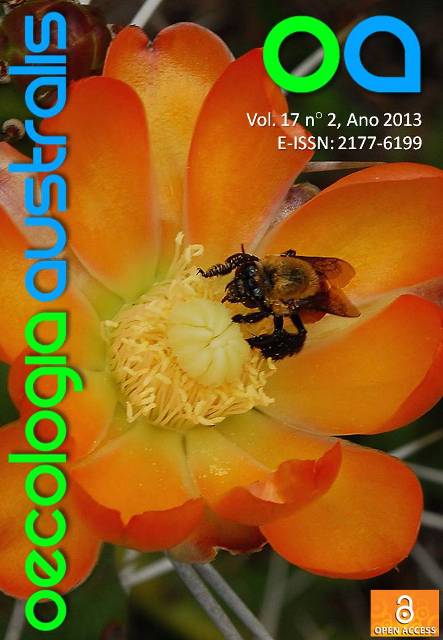DISCRIMINATION FACTOR IN THE TROPHIC ECOLOGY OF FISHES: A REVIEW ABOUT SOURCES OF VARIATION AND METHODS TO OBTAIN IT
Keywords:
isótopos estáveis, ecologia trófica, cienciometriaAbstract
The stable isotope analysis (SIA) has been employed in several areas in Ecology and with different taxonomic groups. This tool has been very important in trophic ecology studies. The basic principle of the SIA is that the proportion of the stable isotopes of an element in an animal tissue could be related with its diet, and it is described by the discrimination factor (DF). The DF is one of the most important parameters in stable isotope analysis. Accurate estimates of the DF are extremely important because they are used in mixture models and to determine the species trophic level. The goals of this study were to quantify, by a scientometric analysis, the research that investigates the sources of variability of the discrimination factor, focusing in fishes. The results obtained were discussed and synthesized, as well the methods employed to estimate the DF. A survey in the ISI Web of Science was performed to find articles related to the theme. Most researches were led by the United States, the United Kingdom and Germany. Muscle was the tissue more commonly utilized. Recently, fin and scale have been used because both represent non-lethal samples. In addition to the use of ?13C and ?15N, interest in using ?D (deuterium) as a food web tracer has been applied in studies with fish. The type of diet, trophic group, metabolic and growth rate appeared to be important sources of variability. The compound-specific isotope analysis of amino acids offers an opportunity to reduce the variation related to the protein content. We believed that there is a need to investigate (i) DF in tropical areas, (ii) the effect of temperature in the DF, (iii) the variation of the DF in different trophic groups. It is recommended greater emphasis in the use of non-lethal samples.
Downloads
Additional Files
- camiladebarros, figura 1.jpg (Português (Brasil))
- camiladebarros, figura 2.jpg (Português (Brasil))
- camiladebarros, figura 3.jpg (Português (Brasil))
- camiladebarros, figura 4.jpg (Português (Brasil))
- camiladebarros, figura 5.jpg (Português (Brasil))
- camiladebarros, figura 6.jpg (Português (Brasil))
- camiladebarros, figura 7.jpg (Português (Brasil))
- Carta de Submissão (Português (Brasil))
- Lista com emails de possíveis revisores (Português (Brasil))
- figura 1 (Português (Brasil))
- figura 2 (Português (Brasil))
- figura 3 (Português (Brasil))
- figura 4 (Português (Brasil))
- figura 4 (Português (Brasil))
- figura 5 (Português (Brasil))
- figura 6 (Português (Brasil))
- figura 7 (Português (Brasil))
- OA_Philippsen & Benedito_isótopos estáveis (2) REVISADO (Português (Brasil))
- Carta de Justificativa OA_Philippsen & Benedito_isótopos estáveis (Português (Brasil))
- FATOR DE DISCRIMINAÇÃO NA ECOLOGIA TRÓFICA DE PEIXES: UMA REVISÃO SOBRE AS FONTES DE VARIAÇÃO E OS MÉTODOS DE OBTENÇÃO (Português (Brasil))


